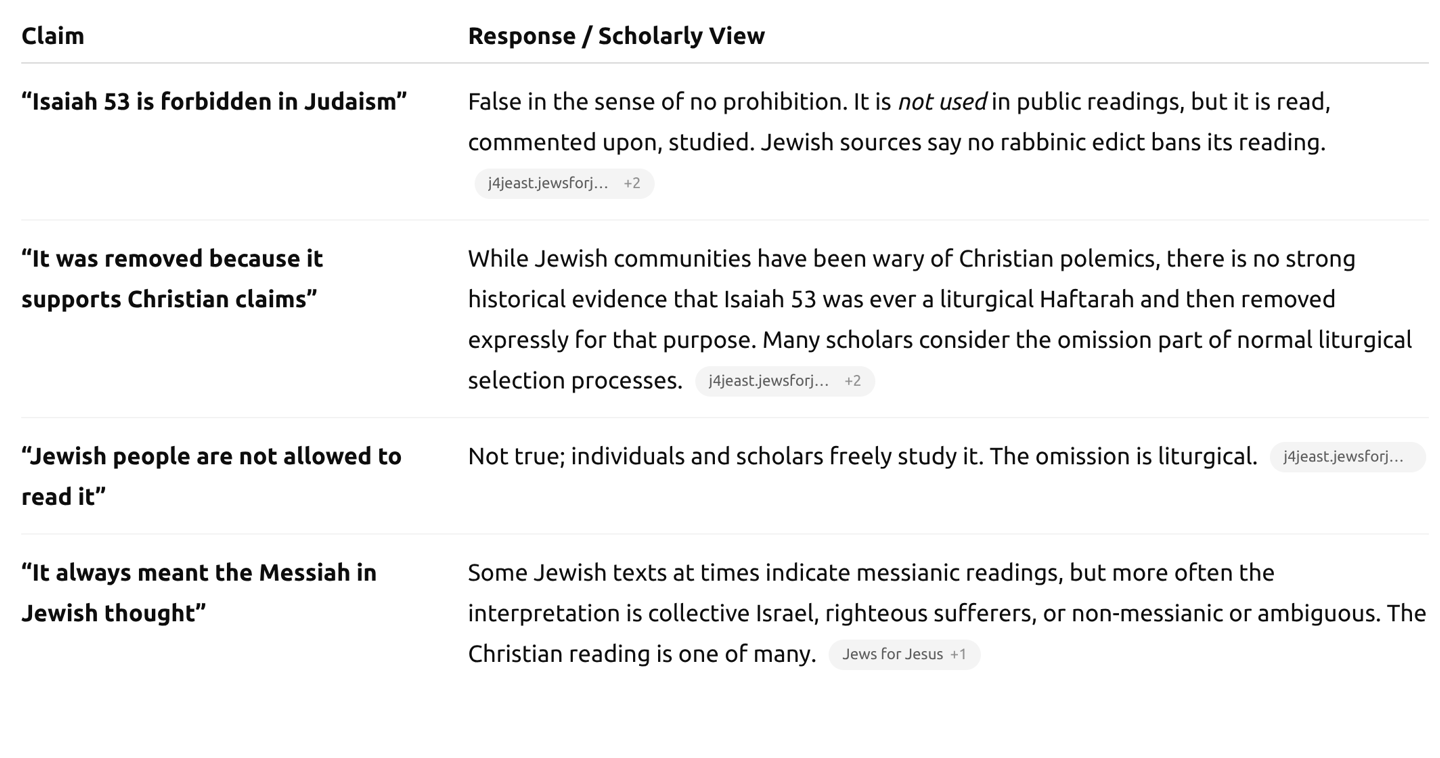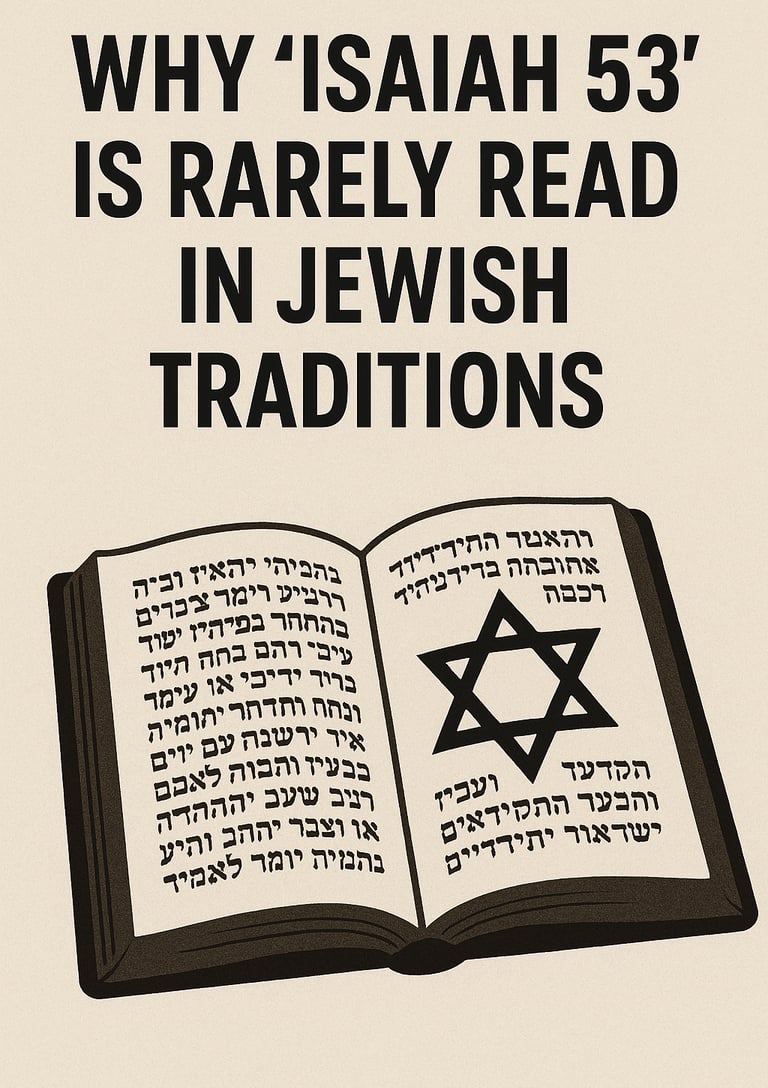WHY 'ISAIAH 53' IS RARELY READ IN JEWISH TRADITIONS
WHY 'ISAIAH 53' IS RARELY READ IN JEWISH TRADITIONS
GOSPEL AND SPIRITUALITY
MrTruth.Tv
9/23/20257 min read
Why Isaiah 53 Is Rarely Read in Jewish Tradition
Isaiah 53 is one of the most discussed, disputed, and revered passages in the Hebrew Bible — often called the “Suffering Servant” chapter. To many outside Judaism it is central to Christian messianic theology; within Judaism, it has been interpreted in multiple ways, and is notably not part of regular synagogue prophetic readings (Haftarah) in practically all Jewish communities. Why is that? What are the historical, liturgical, theological, and textual factors that lead to its rare reading in Jewish worship? Below is a detailed exploration.
Overview of Isaiah 53
Isaiah 53 (more precisely, Isaiah 52:13-53:12) speaks of a “servant” who suffers, is rejected, bears suffering and “iniquities,” is “wounded for our transgressions,” yet through that suffering brings healing, with divine vindication. Its rich, poetic, and difficult imagery has led to a wide variety of interpretations.
What parts of Jewish tradition deal with Isaiah 53
Judaism does engage with Isaiah 53 — in study, commentary, midrash, and theological debate. Key examples:
Rabbinic Literature / Talmud: Certain passages in the Talmud refer to Isaiah 53. For example, Sanhedrin 98b cites verses from Isaiah 53 in the context of discussion of the Messiah. Jews for Jesus+3weekly.israelbiblecenter.com+3Jews for Jesus+3
Medieval Commentators: Rashi (11th-12th century), Ibn Ezra, the Targums, and others offer interpretations. Many Jewish commentators interpret the “servant” as Israel, or as the collective people of Israel suffering for the nations or as righteous individuals rather than a single redemptive messianic figure in Christian sense. whatjewsbelieve.org+3mayimhayim.org+3jewsforjudaism.net+3
Polemical Responses: Jewish apologetics often respond to Christian interpretations of Isaiah 53, emphasizing historic Jewish readings and contextual factors.
So, Judaism has not entirely avoided Isaiah 53; but its reading, especially in liturgy, is limited.
What is the Haftarah and why it matters
To understand why Isaiah 53 is rarely read in public worship, one must understand how Jewish liturgy schedules readings from the Prophets — the Haftarah.
Each Sabbath (and on certain festivals), in addition to the Torah portion (parashah), a selection from the Prophets (Nevi'im) is read. This is the Haftarah. judaismsanswer.com+2whatjewsbelieve.org+2
The portions are selected to correspond in theme or textual link to the weekly Torah portion or to a holiday or other occasion. The Haftarah cycle is fixed. 53isaiah.com+2whatjewsbelieve.org+2
Because Isaiah 53 doesn’t align well with any Torah portion or festival reading themes, it has never been assigned as a Haftarah reading in the normative schedule, in most Jewish communities.
Reasons for absence of Isaiah 53 from Haftarah / public readings
Here are the main factors that scholars and Jewish tradition point to for why Isaiah 53 is not read in Haftarah, and rarely otherwise in synagogue worship:
Lack of thematic match with Torah portions or holidays
As noted, Haftarah readings are chosen with thematic or textual correspondence to the weekly Torah reading. Isaiah 53’s themes (servant-suffering, bearing iniquity, etc.) do not easily map onto particular Torah parashot in a way recognized in Jewish liturgical tradition. Thus, it was not scheduled. whatjewsbelieve.org+253isaiah.com+2
Liturgical tradition / stability of the Haftarah cycle
The Haftarah cycle has been stable (in its communities) for many centuries. Once selections were established, they were preserved. Even as debates and interpretations changed, the cycle was rarely altered to include readings which weren’t part of the traditional pattern.
Interpretative ambiguity / theological caution
Because Isaiah 53 contains language that is vulnerable to Christian messianic appropriation (especially terms like suffering, bearing iniquities, etc.), Jewish scholars and leaders have often been cautious about public liturgical readings that might encourage Christian interpretations among Jewish people. This is not necessarily a conspiracy, but a prudential theological caution and a desire to maintain distinct Jewish interpretative tradition. 4jeast.jewsforjudaism.org+3
Strong tradition of non-messianic readings
Over time, readings that interpret the “servant” as Israel or as the suffering of righteous individuals became normative in most Jewish tradition. These readings reduce the danger (from the Jewish perspective) of misinterpretation by those outside the tradition. The collective suffering of Israel is a well-established metaphor throughout Tanakh. Jews for Judaism+2mayimhayim.org+2
No prohibition on personal or study reading
It is important to note: there is no traditional Jewish law or authoritative edict that prohibits reading Isaiah 53. It is not forbidden. Individuals, scholars, and students may and do read it. The omission is in public liturgical reading.
Uncertainty over identity of the “servant”
Jewish exegesis shows many different possibilities for who the servant is. Some say the servant is Israel (collectively), others say righteous sufferer, or some say possibly the Messiah but in ways very different from Christian theology. Because of this ambiguity, communal liturgical use of the text is more complicated. mayimhayim.org+1
Historical perspectives: Has Isaiah 53 ever been used as a Haftarah?
Some Christian sources claim that Isaiah 53 used to be read in synagogues but was removed, allegedly due to Christian influence. Jewish sources generally deny this, saying there is no historical evidence that Isaiah 53 was ever part of the Haftarah cycle in normative Jewish liturgical tradition. Key points:
No known ancient manuscripts or liturgical sources list Isaiah 53 as a scheduled Haftarah reading.
The argument sometimes comes from noticing that surrounding chapters are used (Isaiah 52 or Isaiah 54) in Haftarot, giving rise to the suspicion that 53 was “skipped” intentionally. But Jewish tradition explains that this is simply a result of how the readings were selected (based on Torah portion themes) and that many passages from prophetic books are never read publicly in Haftarah.
Jews for Judaism and other organizations have addressed and debunked claims of “forbidden chapter” conspiracies, showing lack of historical evidence of intentional suppression and emphasizing the normal practice of omitting many prophetic passages.
Theological Interpretations: The “Servant” in Jewish Thought
Because interpretation influences liturgical use, how Jewish tradition understands the “servant” affects whether and how Isaiah 53 is used.
Some of the main interpretive traditions:


Because of this range of interpretations, there is no single authoritative Jewish position, but a strong tradition of interpreting Isaiah 53 not in the way Christians do, especially in communal or liturgical settings.
Controversies, Misconceptions, and Common Claims
Because Isaiah 53 is so central to Christian theology, many controversies and misunderstandings have arisen. Some common claims and what scholarship / Jewish responses say:
ClaimResponse / Scholarly View
“Isaiah 53 is forbidden in Judaism” False in the sense of no prohibition. It is not used in public readings, but it is read, commented upon, studied. Jewish sources say no rabbinic edict bans its reading.
“It was removed because it supports Christian claims” While Jewish communities have been wary of Christian polemics, there is no strong historical evidence that Isaiah 53 was ever a liturgical Haftarah and then removed expressly for that purpose. Many scholars consider the omission part of normal liturgical selection processes.
“Jewish people are not allowed to read it” Not true; individuals and scholars freely study it. The omission is liturgical. j4jeast.jewsforjudaism.org “It always meant the Messiah in Jewish thought” Some Jewish texts at times indicate messianic readings, but more often the interpretation is collective Israel, righteous sufferers, or non-messianic or ambiguous. The Christian reading is one of many.
Academic / Historical Perspectives
Modern scholars bring additional insight based on textual criticism, liturgical history, comparative religion, and manuscripts.
Earliest Jewish interpretations: Some early Jewish sources, including Targum Jonathan (an early Aramaic paraphrase/commentary) and midrashic literature, show messianic or semi-messianic reading of parts of Isaiah 53, though often qualified or interpreted in ways distinct from Christian doctrine. Jews for Jesus+1
Liturgical history: The fixed Haftarah cycles appear to have been codified in the early centuries CE; by the time of the Mishnah and Talmud there was already a strong custom of selecting prophetic readings that corresponded to scriptural themes for Torah portions. Texts that didn’t fit were left out. whatjewsbelieve.org+1
Polemic pressures: As Christianity grew and used Hebrew scriptures (including Isaiah 53) in its messianic claims, Jewish thinkers felt the need to clarify that their tradition did not accept the Christian theological framing. This reinforced non-messianic or national Israel readings of Isaiah 53. The historical trauma of forced conversion, missionizing, and legal/social pressures in some periods likely contributed to caution in public usage. jewishawareness.org+2jewsforjudaism.net+2
Implications for Jewish Worship & Identity
Because liturgy is central to communal identity, what is read publicly has symbolic importance. Some implications:
By omitting Isaiah 53, Jewish liturgical tradition shifts the focus away from passages that might be interpreted in ways seen as aligning with Christian theology.
The selection of Haftarah passages reinforces a Jewish reading, theological identity, and traditional interpretative approaches: that the Servant figure often refers to Israel, or suffers collectively, or that redemption is national as well as individual, but not in the Christian substitutionary atonement model.
The stability of tradition matters: changing the set Haftarah readings (after centuries) is very difficult, both practically and spiritually.
Summary: Why Isaiah 53 Is Rarely Read in Synagogue
Putting it all together, the reasons Isaiah 53 is rarely read in synagogue tradition (Haftarah or otherwise) are multifaceted:
It lacks alignment with existing Torah-portion or festival themes, which is a standard criterion for inclusion in Haftarah.
The traditional Haftarah cycle is stable and does not include many prophetic texts — omission is thus not unique to Isaiah 53.
The theological risk of misinterpretation (particularly by those outside the Jewish tradition) has made communities cautious about giving Isaiah 53 liturgical prominence.
Jewish tradition tends to read this chapter in a non-Christian messianic way: as Israel, the righteous, or suffering righteous individuals, instead of as a Christ-type savior who dies for the sins of humanity.
There is no outright prohibition; the omission is a function of liturgy, interpretation, and tradition rather than censorship in law.
Areas of Ongoing Debate & Uncertainty
Even with these explanations, certain questions remain open among scholars and religious thinkers:
Historical Chronology: Exactly when did the understandings solidify that Isaiah 53 should be interpreted in a non-Christian way? Did certain rabbis shift interpretations explicitly in response to Christian claims? If so, when and in what communities?
Extent of Messianic Interpretation in Jewish Sources: While there is evidence of messianic readings, the extent to which these were mainstream (versus marginal, speculative, or polemical) is debated.
Potential for Change: Some Jewish thinkers believe that Isaiah 53 might be incorporated more in teaching or liturgical contexts in modern times, especially in Jewish-Christian dialogue or in Messianic Jewish movements. Whether this will happen widely is uncertain.
Conclusion
Isaiah 53 holds a unique place in the religious imagination of both Judaism and Christianity. Within Judaism, its rare reading in public liturgy reflects more than avoidance: it is a product of centuries of theological interpretation, liturgical custom, identity formation, and response to external pressures. The tradition does not view Isaiah 53 as “forbidden,” but rather as text to be handled with care — studied, commented, and interpreted — but not necessarily elevated in public worship in ways that might mislead or cause confusion with Christian doctrine.
If you want, I can share a version of this article oriented specifically toward comparing Christian and Jewish interpretations, or with more ancient Jewish source texts (Midrash, Talmud) with original Hebrew and analysis. Would that be helpful?




